Parkinson Disease: Symptoms, Diagnosis, Treatment, and Prevention
VerifiedAdded on 2023/01/05
|7
|1748
|69
Report
AI Summary
This report provides a comprehensive overview of Parkinson's Disease, a neurodegenerative disorder affecting movement. It details the various symptoms, including tremors, muscle rigidity, slowed movement, and non-motor symptoms like cognitive changes and sleep disturbances. The report explores the diagnostic process and highlights the role of dopamine in the disease. It discusses various treatment options, including medications like Levodopa and anticholinergics, and alternative treatments such as diet and exercise. The report also touches upon preventative measures like consuming flavonoids and avoiding toxins. Overall, the report aims to provide a thorough understanding of Parkinson's Disease, its management, and potential prevention strategies.

Running Head: PARKINSON DISEASE 0
Parkinson Disease
Parkinson Disease
Paraphrase This Document
Need a fresh take? Get an instant paraphrase of this document with our AI Paraphraser
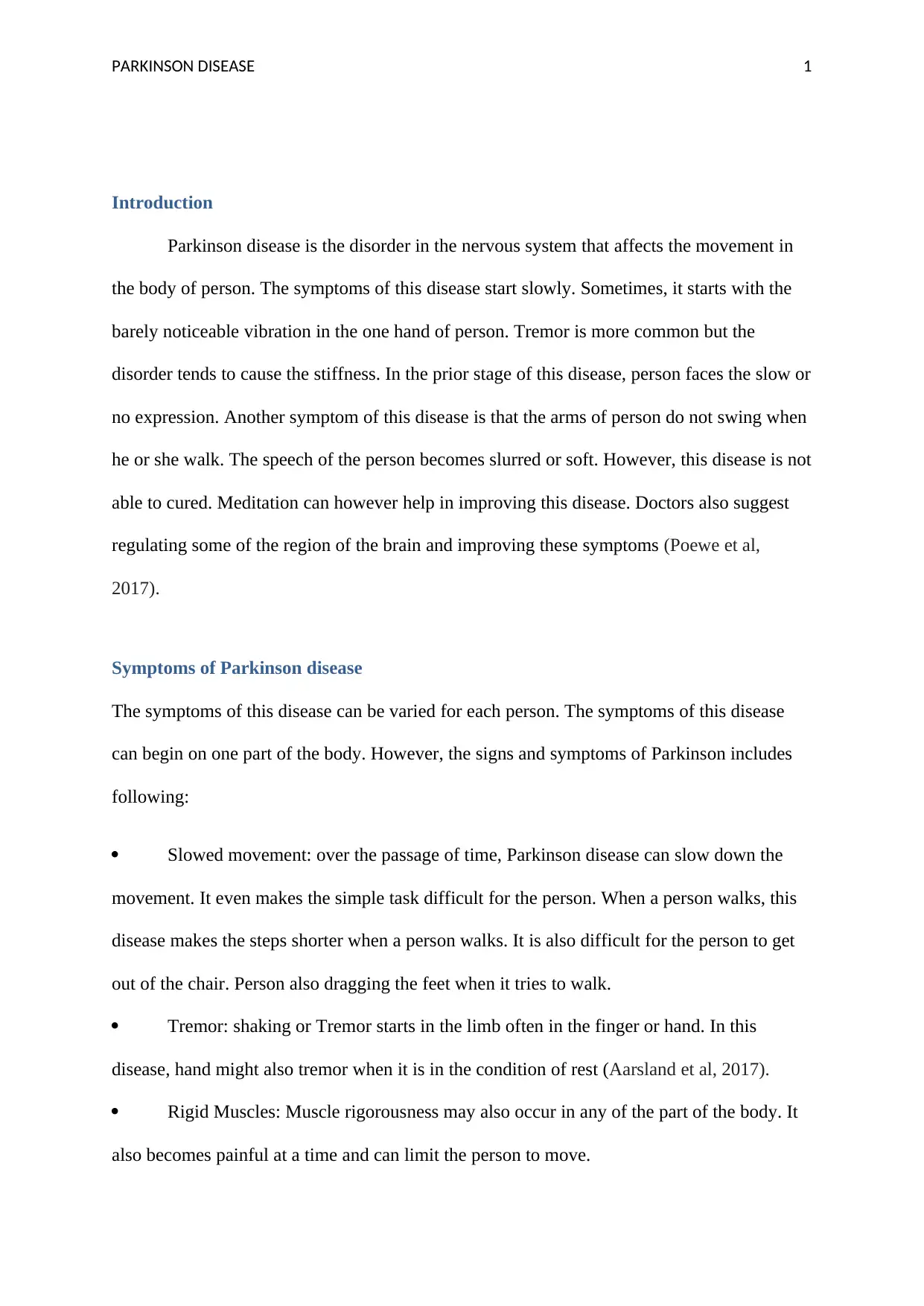
PARKINSON DISEASE 1
Introduction
Parkinson disease is the disorder in the nervous system that affects the movement in
the body of person. The symptoms of this disease start slowly. Sometimes, it starts with the
barely noticeable vibration in the one hand of person. Tremor is more common but the
disorder tends to cause the stiffness. In the prior stage of this disease, person faces the slow or
no expression. Another symptom of this disease is that the arms of person do not swing when
he or she walk. The speech of the person becomes slurred or soft. However, this disease is not
able to cured. Meditation can however help in improving this disease. Doctors also suggest
regulating some of the region of the brain and improving these symptoms (Poewe et al,
2017).
Symptoms of Parkinson disease
The symptoms of this disease can be varied for each person. The symptoms of this disease
can begin on one part of the body. However, the signs and symptoms of Parkinson includes
following:
Slowed movement: over the passage of time, Parkinson disease can slow down the
movement. It even makes the simple task difficult for the person. When a person walks, this
disease makes the steps shorter when a person walks. It is also difficult for the person to get
out of the chair. Person also dragging the feet when it tries to walk.
Tremor: shaking or Tremor starts in the limb often in the finger or hand. In this
disease, hand might also tremor when it is in the condition of rest (Aarsland et al, 2017).
Rigid Muscles: Muscle rigorousness may also occur in any of the part of the body. It
also becomes painful at a time and can limit the person to move.
Introduction
Parkinson disease is the disorder in the nervous system that affects the movement in
the body of person. The symptoms of this disease start slowly. Sometimes, it starts with the
barely noticeable vibration in the one hand of person. Tremor is more common but the
disorder tends to cause the stiffness. In the prior stage of this disease, person faces the slow or
no expression. Another symptom of this disease is that the arms of person do not swing when
he or she walk. The speech of the person becomes slurred or soft. However, this disease is not
able to cured. Meditation can however help in improving this disease. Doctors also suggest
regulating some of the region of the brain and improving these symptoms (Poewe et al,
2017).
Symptoms of Parkinson disease
The symptoms of this disease can be varied for each person. The symptoms of this disease
can begin on one part of the body. However, the signs and symptoms of Parkinson includes
following:
Slowed movement: over the passage of time, Parkinson disease can slow down the
movement. It even makes the simple task difficult for the person. When a person walks, this
disease makes the steps shorter when a person walks. It is also difficult for the person to get
out of the chair. Person also dragging the feet when it tries to walk.
Tremor: shaking or Tremor starts in the limb often in the finger or hand. In this
disease, hand might also tremor when it is in the condition of rest (Aarsland et al, 2017).
Rigid Muscles: Muscle rigorousness may also occur in any of the part of the body. It
also becomes painful at a time and can limit the person to move.
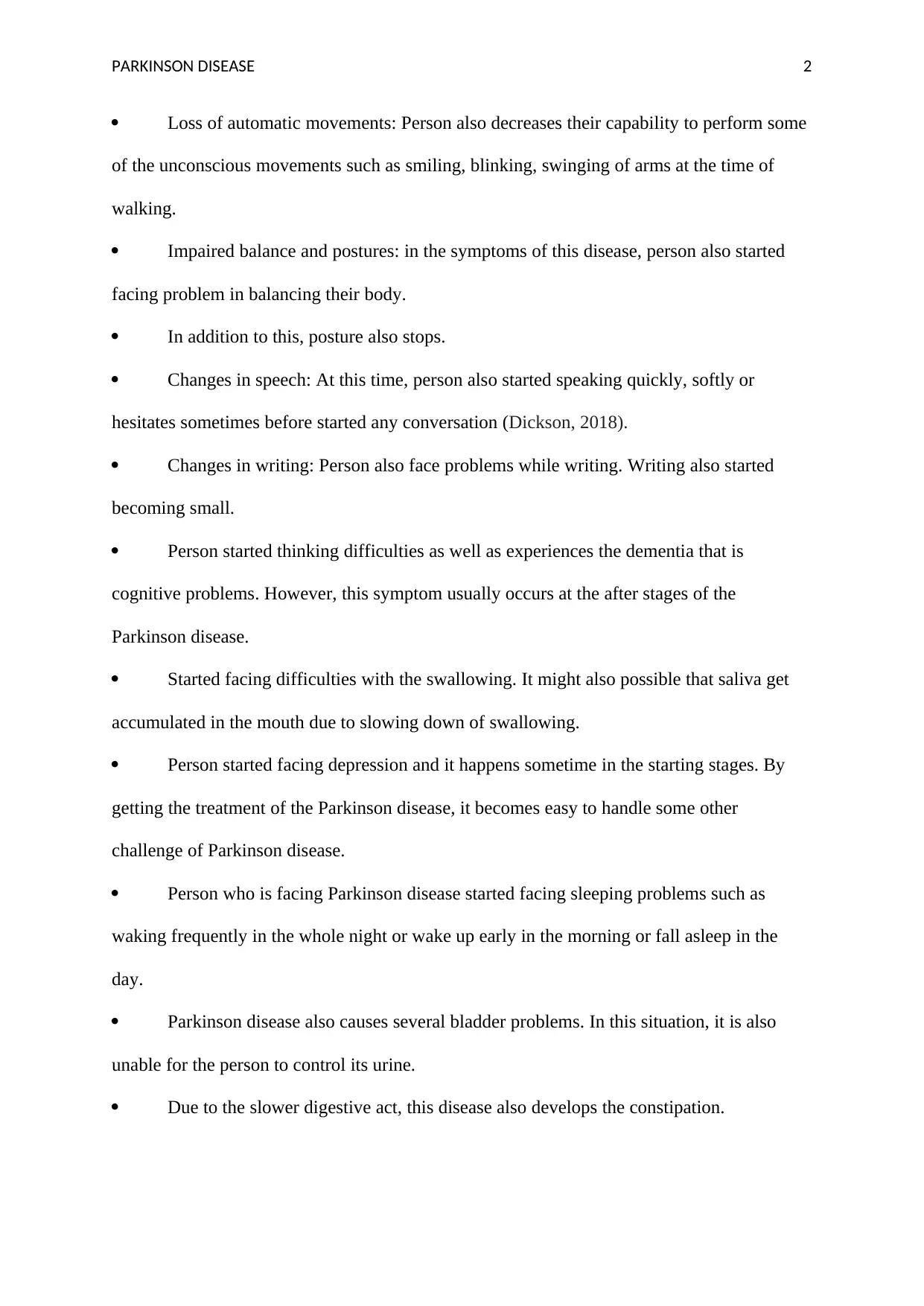
PARKINSON DISEASE 2
Loss of automatic movements: Person also decreases their capability to perform some
of the unconscious movements such as smiling, blinking, swinging of arms at the time of
walking.
Impaired balance and postures: in the symptoms of this disease, person also started
facing problem in balancing their body.
In addition to this, posture also stops.
Changes in speech: At this time, person also started speaking quickly, softly or
hesitates sometimes before started any conversation (Dickson, 2018).
Changes in writing: Person also face problems while writing. Writing also started
becoming small.
Person started thinking difficulties as well as experiences the dementia that is
cognitive problems. However, this symptom usually occurs at the after stages of the
Parkinson disease.
Started facing difficulties with the swallowing. It might also possible that saliva get
accumulated in the mouth due to slowing down of swallowing.
Person started facing depression and it happens sometime in the starting stages. By
getting the treatment of the Parkinson disease, it becomes easy to handle some other
challenge of Parkinson disease.
Person who is facing Parkinson disease started facing sleeping problems such as
waking frequently in the whole night or wake up early in the morning or fall asleep in the
day.
Parkinson disease also causes several bladder problems. In this situation, it is also
unable for the person to control its urine.
Due to the slower digestive act, this disease also develops the constipation.
Loss of automatic movements: Person also decreases their capability to perform some
of the unconscious movements such as smiling, blinking, swinging of arms at the time of
walking.
Impaired balance and postures: in the symptoms of this disease, person also started
facing problem in balancing their body.
In addition to this, posture also stops.
Changes in speech: At this time, person also started speaking quickly, softly or
hesitates sometimes before started any conversation (Dickson, 2018).
Changes in writing: Person also face problems while writing. Writing also started
becoming small.
Person started thinking difficulties as well as experiences the dementia that is
cognitive problems. However, this symptom usually occurs at the after stages of the
Parkinson disease.
Started facing difficulties with the swallowing. It might also possible that saliva get
accumulated in the mouth due to slowing down of swallowing.
Person started facing depression and it happens sometime in the starting stages. By
getting the treatment of the Parkinson disease, it becomes easy to handle some other
challenge of Parkinson disease.
Person who is facing Parkinson disease started facing sleeping problems such as
waking frequently in the whole night or wake up early in the morning or fall asleep in the
day.
Parkinson disease also causes several bladder problems. In this situation, it is also
unable for the person to control its urine.
Due to the slower digestive act, this disease also develops the constipation.
⊘ This is a preview!⊘
Do you want full access?
Subscribe today to unlock all pages.

Trusted by 1+ million students worldwide
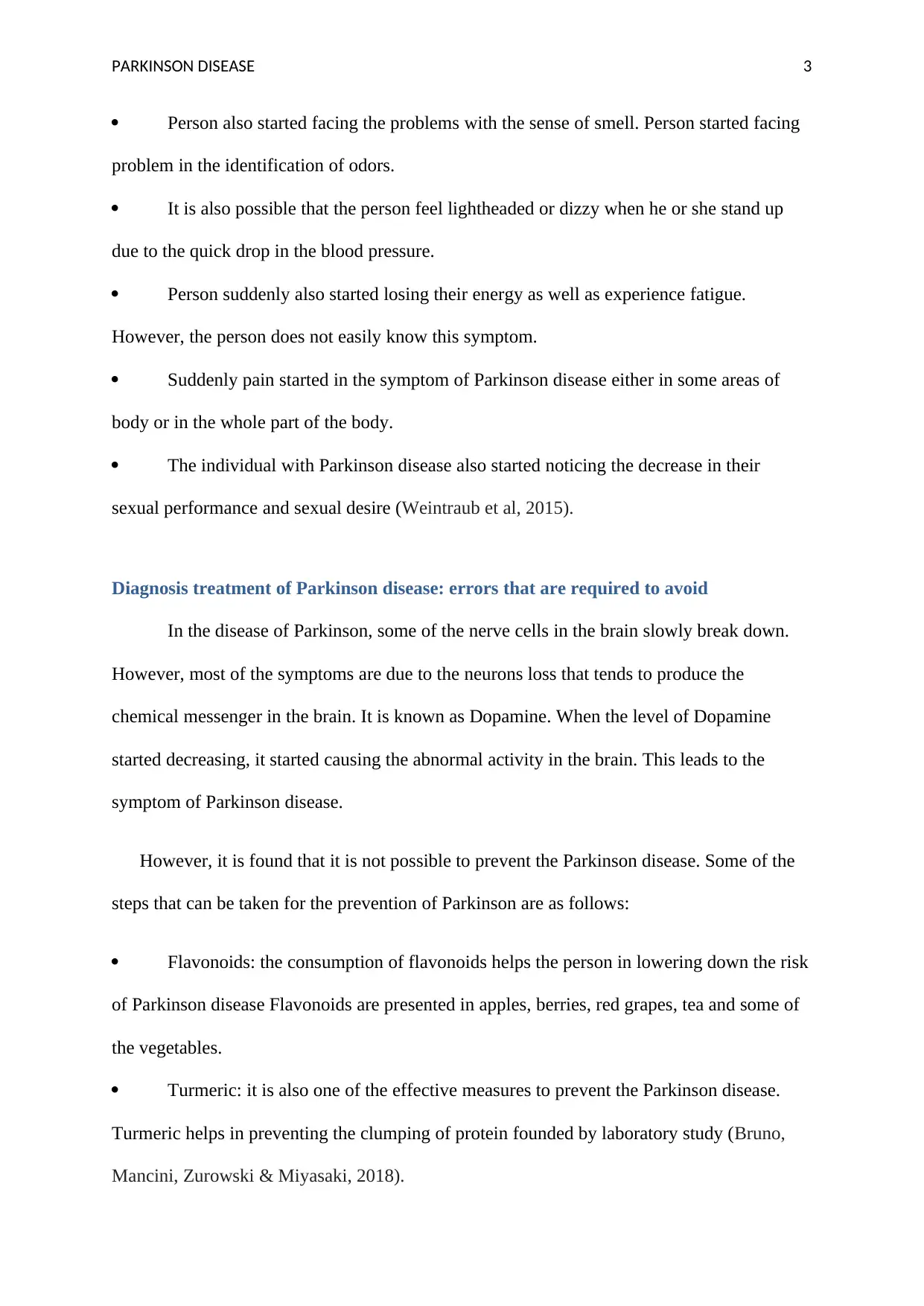
PARKINSON DISEASE 3
Person also started facing the problems with the sense of smell. Person started facing
problem in the identification of odors.
It is also possible that the person feel lightheaded or dizzy when he or she stand up
due to the quick drop in the blood pressure.
Person suddenly also started losing their energy as well as experience fatigue.
However, the person does not easily know this symptom.
Suddenly pain started in the symptom of Parkinson disease either in some areas of
body or in the whole part of the body.
The individual with Parkinson disease also started noticing the decrease in their
sexual performance and sexual desire (Weintraub et al, 2015).
Diagnosis treatment of Parkinson disease: errors that are required to avoid
In the disease of Parkinson, some of the nerve cells in the brain slowly break down.
However, most of the symptoms are due to the neurons loss that tends to produce the
chemical messenger in the brain. It is known as Dopamine. When the level of Dopamine
started decreasing, it started causing the abnormal activity in the brain. This leads to the
symptom of Parkinson disease.
However, it is found that it is not possible to prevent the Parkinson disease. Some of the
steps that can be taken for the prevention of Parkinson are as follows:
Flavonoids: the consumption of flavonoids helps the person in lowering down the risk
of Parkinson disease Flavonoids are presented in apples, berries, red grapes, tea and some of
the vegetables.
Turmeric: it is also one of the effective measures to prevent the Parkinson disease.
Turmeric helps in preventing the clumping of protein founded by laboratory study (Bruno,
Mancini, Zurowski & Miyasaki, 2018).
Person also started facing the problems with the sense of smell. Person started facing
problem in the identification of odors.
It is also possible that the person feel lightheaded or dizzy when he or she stand up
due to the quick drop in the blood pressure.
Person suddenly also started losing their energy as well as experience fatigue.
However, the person does not easily know this symptom.
Suddenly pain started in the symptom of Parkinson disease either in some areas of
body or in the whole part of the body.
The individual with Parkinson disease also started noticing the decrease in their
sexual performance and sexual desire (Weintraub et al, 2015).
Diagnosis treatment of Parkinson disease: errors that are required to avoid
In the disease of Parkinson, some of the nerve cells in the brain slowly break down.
However, most of the symptoms are due to the neurons loss that tends to produce the
chemical messenger in the brain. It is known as Dopamine. When the level of Dopamine
started decreasing, it started causing the abnormal activity in the brain. This leads to the
symptom of Parkinson disease.
However, it is found that it is not possible to prevent the Parkinson disease. Some of the
steps that can be taken for the prevention of Parkinson are as follows:
Flavonoids: the consumption of flavonoids helps the person in lowering down the risk
of Parkinson disease Flavonoids are presented in apples, berries, red grapes, tea and some of
the vegetables.
Turmeric: it is also one of the effective measures to prevent the Parkinson disease.
Turmeric helps in preventing the clumping of protein founded by laboratory study (Bruno,
Mancini, Zurowski & Miyasaki, 2018).
Paraphrase This Document
Need a fresh take? Get an instant paraphrase of this document with our AI Paraphraser
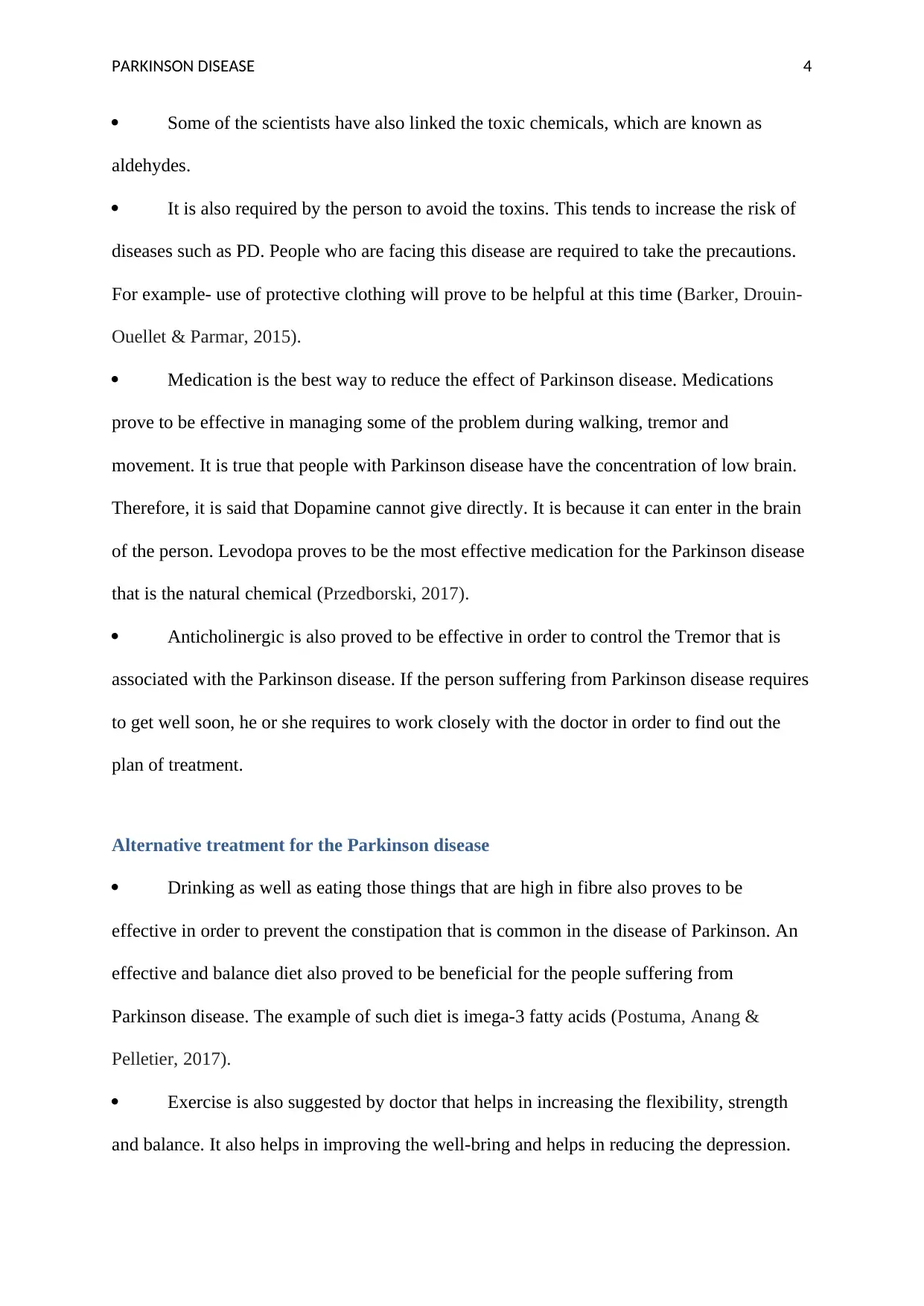
PARKINSON DISEASE 4
Some of the scientists have also linked the toxic chemicals, which are known as
aldehydes.
It is also required by the person to avoid the toxins. This tends to increase the risk of
diseases such as PD. People who are facing this disease are required to take the precautions.
For example- use of protective clothing will prove to be helpful at this time (Barker, Drouin-
Ouellet & Parmar, 2015).
Medication is the best way to reduce the effect of Parkinson disease. Medications
prove to be effective in managing some of the problem during walking, tremor and
movement. It is true that people with Parkinson disease have the concentration of low brain.
Therefore, it is said that Dopamine cannot give directly. It is because it can enter in the brain
of the person. Levodopa proves to be the most effective medication for the Parkinson disease
that is the natural chemical (Przedborski, 2017).
Anticholinergic is also proved to be effective in order to control the Tremor that is
associated with the Parkinson disease. If the person suffering from Parkinson disease requires
to get well soon, he or she requires to work closely with the doctor in order to find out the
plan of treatment.
Alternative treatment for the Parkinson disease
Drinking as well as eating those things that are high in fibre also proves to be
effective in order to prevent the constipation that is common in the disease of Parkinson. An
effective and balance diet also proved to be beneficial for the people suffering from
Parkinson disease. The example of such diet is imega-3 fatty acids (Postuma, Anang &
Pelletier, 2017).
Exercise is also suggested by doctor that helps in increasing the flexibility, strength
and balance. It also helps in improving the well-bring and helps in reducing the depression.
Some of the scientists have also linked the toxic chemicals, which are known as
aldehydes.
It is also required by the person to avoid the toxins. This tends to increase the risk of
diseases such as PD. People who are facing this disease are required to take the precautions.
For example- use of protective clothing will prove to be helpful at this time (Barker, Drouin-
Ouellet & Parmar, 2015).
Medication is the best way to reduce the effect of Parkinson disease. Medications
prove to be effective in managing some of the problem during walking, tremor and
movement. It is true that people with Parkinson disease have the concentration of low brain.
Therefore, it is said that Dopamine cannot give directly. It is because it can enter in the brain
of the person. Levodopa proves to be the most effective medication for the Parkinson disease
that is the natural chemical (Przedborski, 2017).
Anticholinergic is also proved to be effective in order to control the Tremor that is
associated with the Parkinson disease. If the person suffering from Parkinson disease requires
to get well soon, he or she requires to work closely with the doctor in order to find out the
plan of treatment.
Alternative treatment for the Parkinson disease
Drinking as well as eating those things that are high in fibre also proves to be
effective in order to prevent the constipation that is common in the disease of Parkinson. An
effective and balance diet also proved to be beneficial for the people suffering from
Parkinson disease. The example of such diet is imega-3 fatty acids (Postuma, Anang &
Pelletier, 2017).
Exercise is also suggested by doctor that helps in increasing the flexibility, strength
and balance. It also helps in improving the well-bring and helps in reducing the depression.
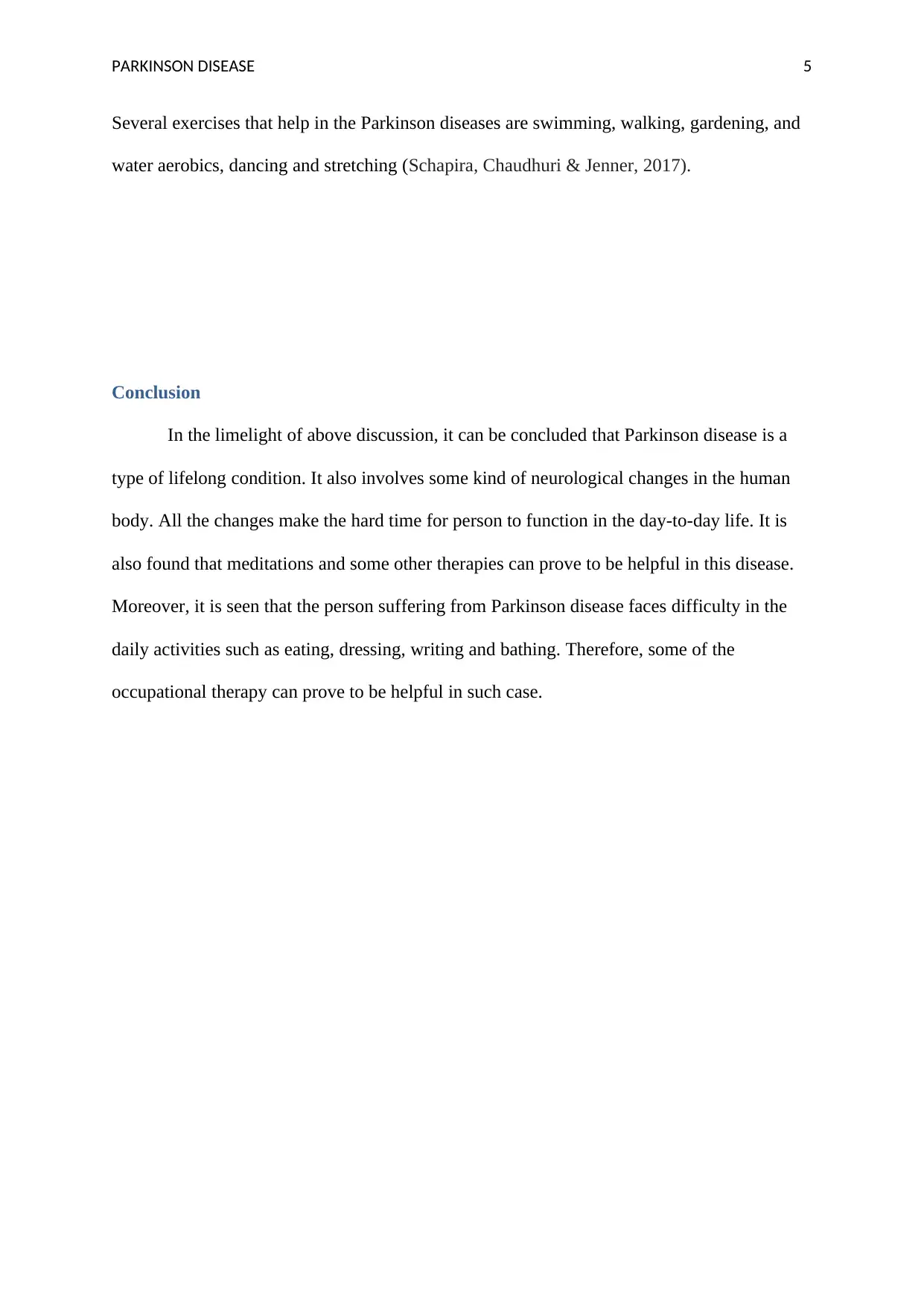
PARKINSON DISEASE 5
Several exercises that help in the Parkinson diseases are swimming, walking, gardening, and
water aerobics, dancing and stretching (Schapira, Chaudhuri & Jenner, 2017).
Conclusion
In the limelight of above discussion, it can be concluded that Parkinson disease is a
type of lifelong condition. It also involves some kind of neurological changes in the human
body. All the changes make the hard time for person to function in the day-to-day life. It is
also found that meditations and some other therapies can prove to be helpful in this disease.
Moreover, it is seen that the person suffering from Parkinson disease faces difficulty in the
daily activities such as eating, dressing, writing and bathing. Therefore, some of the
occupational therapy can prove to be helpful in such case.
Several exercises that help in the Parkinson diseases are swimming, walking, gardening, and
water aerobics, dancing and stretching (Schapira, Chaudhuri & Jenner, 2017).
Conclusion
In the limelight of above discussion, it can be concluded that Parkinson disease is a
type of lifelong condition. It also involves some kind of neurological changes in the human
body. All the changes make the hard time for person to function in the day-to-day life. It is
also found that meditations and some other therapies can prove to be helpful in this disease.
Moreover, it is seen that the person suffering from Parkinson disease faces difficulty in the
daily activities such as eating, dressing, writing and bathing. Therefore, some of the
occupational therapy can prove to be helpful in such case.
⊘ This is a preview!⊘
Do you want full access?
Subscribe today to unlock all pages.

Trusted by 1+ million students worldwide
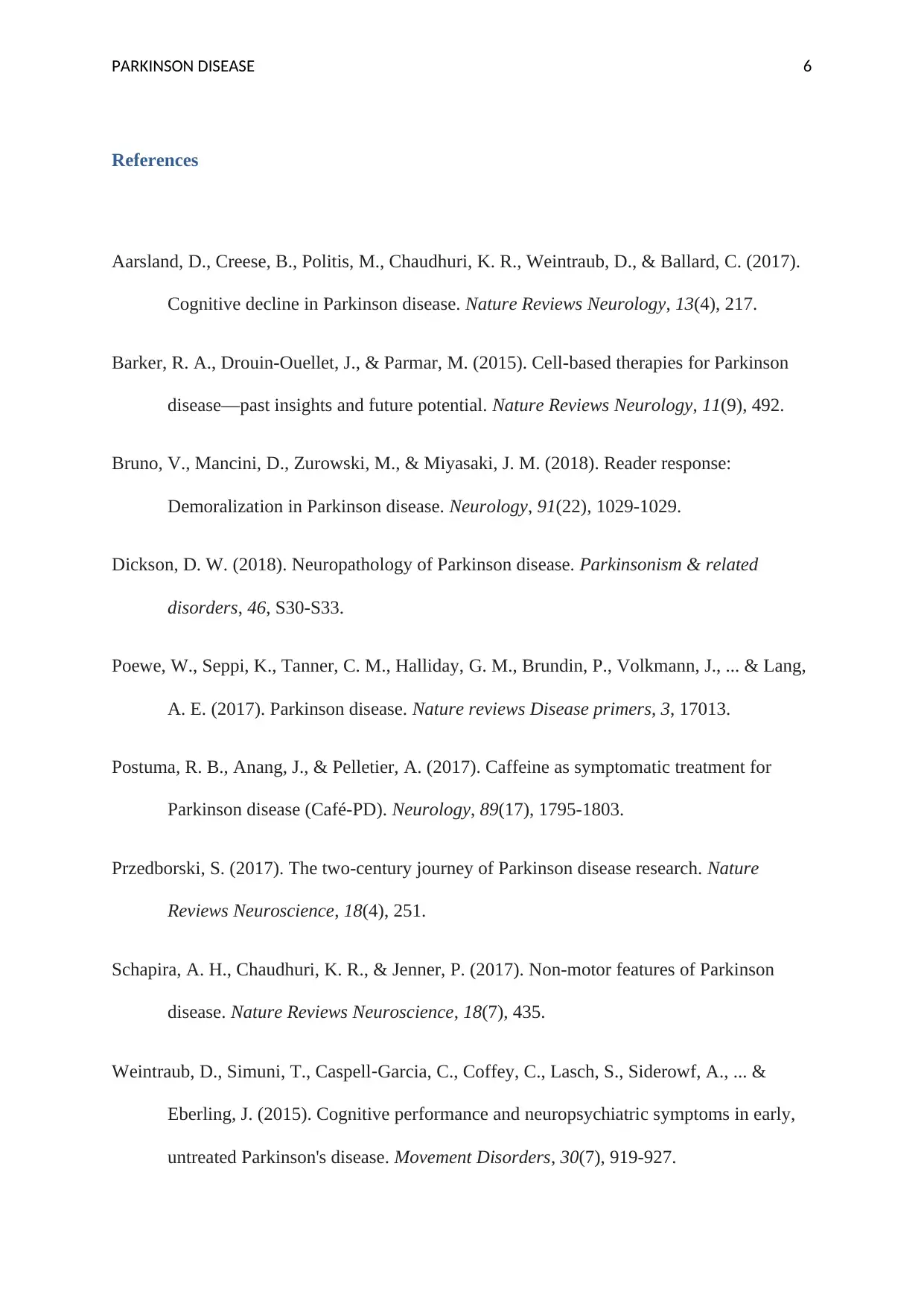
PARKINSON DISEASE 6
References
Aarsland, D., Creese, B., Politis, M., Chaudhuri, K. R., Weintraub, D., & Ballard, C. (2017).
Cognitive decline in Parkinson disease. Nature Reviews Neurology, 13(4), 217.
Barker, R. A., Drouin-Ouellet, J., & Parmar, M. (2015). Cell-based therapies for Parkinson
disease—past insights and future potential. Nature Reviews Neurology, 11(9), 492.
Bruno, V., Mancini, D., Zurowski, M., & Miyasaki, J. M. (2018). Reader response:
Demoralization in Parkinson disease. Neurology, 91(22), 1029-1029.
Dickson, D. W. (2018). Neuropathology of Parkinson disease. Parkinsonism & related
disorders, 46, S30-S33.
Poewe, W., Seppi, K., Tanner, C. M., Halliday, G. M., Brundin, P., Volkmann, J., ... & Lang,
A. E. (2017). Parkinson disease. Nature reviews Disease primers, 3, 17013.
Postuma, R. B., Anang, J., & Pelletier, A. (2017). Caffeine as symptomatic treatment for
Parkinson disease (Café-PD). Neurology, 89(17), 1795-1803.
Przedborski, S. (2017). The two-century journey of Parkinson disease research. Nature
Reviews Neuroscience, 18(4), 251.
Schapira, A. H., Chaudhuri, K. R., & Jenner, P. (2017). Non-motor features of Parkinson
disease. Nature Reviews Neuroscience, 18(7), 435.
Weintraub, D., Simuni, T., Caspell‐Garcia, C., Coffey, C., Lasch, S., Siderowf, A., ... &
Eberling, J. (2015). Cognitive performance and neuropsychiatric symptoms in early,
untreated Parkinson's disease. Movement Disorders, 30(7), 919-927.
References
Aarsland, D., Creese, B., Politis, M., Chaudhuri, K. R., Weintraub, D., & Ballard, C. (2017).
Cognitive decline in Parkinson disease. Nature Reviews Neurology, 13(4), 217.
Barker, R. A., Drouin-Ouellet, J., & Parmar, M. (2015). Cell-based therapies for Parkinson
disease—past insights and future potential. Nature Reviews Neurology, 11(9), 492.
Bruno, V., Mancini, D., Zurowski, M., & Miyasaki, J. M. (2018). Reader response:
Demoralization in Parkinson disease. Neurology, 91(22), 1029-1029.
Dickson, D. W. (2018). Neuropathology of Parkinson disease. Parkinsonism & related
disorders, 46, S30-S33.
Poewe, W., Seppi, K., Tanner, C. M., Halliday, G. M., Brundin, P., Volkmann, J., ... & Lang,
A. E. (2017). Parkinson disease. Nature reviews Disease primers, 3, 17013.
Postuma, R. B., Anang, J., & Pelletier, A. (2017). Caffeine as symptomatic treatment for
Parkinson disease (Café-PD). Neurology, 89(17), 1795-1803.
Przedborski, S. (2017). The two-century journey of Parkinson disease research. Nature
Reviews Neuroscience, 18(4), 251.
Schapira, A. H., Chaudhuri, K. R., & Jenner, P. (2017). Non-motor features of Parkinson
disease. Nature Reviews Neuroscience, 18(7), 435.
Weintraub, D., Simuni, T., Caspell‐Garcia, C., Coffey, C., Lasch, S., Siderowf, A., ... &
Eberling, J. (2015). Cognitive performance and neuropsychiatric symptoms in early,
untreated Parkinson's disease. Movement Disorders, 30(7), 919-927.
1 out of 7
Related Documents
Your All-in-One AI-Powered Toolkit for Academic Success.
+13062052269
info@desklib.com
Available 24*7 on WhatsApp / Email
![[object Object]](/_next/static/media/star-bottom.7253800d.svg)
Unlock your academic potential
Copyright © 2020–2025 A2Z Services. All Rights Reserved. Developed and managed by ZUCOL.





